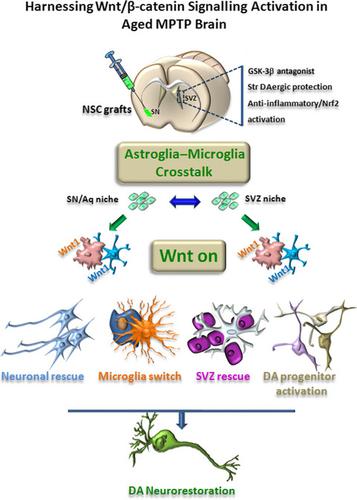当前位置:
X-MOL 学术
›
Aging Cell
›
论文详情
Our official English website, www.x-mol.net, welcomes your
feedback! (Note: you will need to create a separate account there.)
Parkinson's disease, aging and adult neurogenesis: Wnt/β-catenin signalling as the key to unlock the mystery of endogenous brain repair.
Aging Cell ( IF 8.0 ) Pub Date : 2020-02-12 , DOI: 10.1111/acel.13101 Bianca Marchetti 1, 2 , Cataldo Tirolo 2 , Francesca L'Episcopo 2 , Salvatore Caniglia 2 , Nunzio Testa 2 , Jayden A Smith 3 , Stefano Pluchino 3 , Maria F Serapide 1
Aging Cell ( IF 8.0 ) Pub Date : 2020-02-12 , DOI: 10.1111/acel.13101 Bianca Marchetti 1, 2 , Cataldo Tirolo 2 , Francesca L'Episcopo 2 , Salvatore Caniglia 2 , Nunzio Testa 2 , Jayden A Smith 3 , Stefano Pluchino 3 , Maria F Serapide 1
Affiliation

|
A common hallmark of age‐dependent neurodegenerative diseases is an impairment of adult neurogenesis. Wingless‐type mouse mammary tumor virus integration site (Wnt)/β‐catenin (WβC) signalling is a vital pathway for dopaminergic (DAergic) neurogenesis and an essential signalling system during embryonic development and aging, the most critical risk factor for Parkinson's disease (PD). To date, there is no known cause or cure for PD. Here we focus on the potential to reawaken the impaired neurogenic niches to rejuvenate and repair the aged PD brain. Specifically, we highlight WβC‐signalling in the plasticity of the subventricular zone (SVZ), the largest germinal region in the mature brain innervated by nigrostriatal DAergic terminals, and the mesencephalic aqueduct‐periventricular region (Aq‐PVR) Wnt‐sensitive niche, which is in proximity to the SNpc and harbors neural stem progenitor cells (NSCs) with DAergic potential. The hallmark of the WβC pathway is the cytosolic accumulation of β‐catenin, which enters the nucleus and associates with T cell factor/lymphoid enhancer binding factor (TCF/LEF) transcription factors, leading to the transcription of Wnt target genes. Here, we underscore the dynamic interplay between DAergic innervation and astroglial‐derived factors regulating WβC‐dependent transcription of key genes orchestrating NSC proliferation, survival, migration and differentiation. Aging, inflammation and oxidative stress synergize with neurotoxin exposure in “turning off” the WβC neurogenic switch via down‐regulation of the nuclear factor erythroid‐2‐related factor 2/Wnt‐regulated signalosome, a key player in the maintenance of antioxidant self‐defense mechanisms and NSC homeostasis. Harnessing WβC‐signalling in the aged PD brain can thus restore neurogenesis, rejuvenate the microenvironment, and promote neurorescue and regeneration.
中文翻译:

帕金森病、衰老和成人神经发生:Wnt/β-连环蛋白信号传导是解开内源性大脑修复之谜的关键。
年龄依赖性神经退行性疾病的一个共同特征是成人神经发生受损。无翅型小鼠乳腺肿瘤病毒整合位点(Wnt)/β-连环蛋白(WβC)信号是多巴胺能(DAergic)神经发生的重要途径,也是胚胎发育和衰老过程中的重要信号系统,是帕金森病最关键的危险因素。 PD)。迄今为止,帕金森病尚无已知的病因或治愈方法。在这里,我们重点关注重新唤醒受损的神经源性生态位,以恢复和修复老化的帕金森病大脑的潜力。具体来说,我们强调了脑室下区 (SVZ) 可塑性中的 WβC信号传导,脑室下区是成熟大脑中受黑质纹状体 DAergic 末梢支配的最大生发区域,以及中脑导水管-脑室周围区域 (Aq-PVR) Wnt 敏感生态位,其中靠近 SNpc,并含有具有 DAergic 潜力的神经干祖细胞 (NSC)。WβC途径的标志是β-连环蛋白在细胞质中积累,进入细胞核并与T细胞因子/淋巴增强子结合因子(TCF/LEF)转录因子结合,导致Wnt靶基因的转录。在这里,我们强调了 DAergic 神经支配和星形胶质细胞衍生因子之间的动态相互作用,这些因子调节协调 NSC 增殖、存活、迁移和分化的关键基因的 WβC 依赖性转录。衰老、炎症和氧化应激与神经毒素暴露协同作用,通过下调核因子红细胞 2 相关因子 2/Wnt 调节信号体,“关闭”WβC 神经源性开关,而信号体是维持抗氧化自身的关键因素。防御机制和 NSC 稳态。因此,利用老年 PD 大脑中的 WβC 信号传导可以恢复神经发生、恢复微环境活力并促进神经抢救和再生。
更新日期:2020-02-12
中文翻译:

帕金森病、衰老和成人神经发生:Wnt/β-连环蛋白信号传导是解开内源性大脑修复之谜的关键。
年龄依赖性神经退行性疾病的一个共同特征是成人神经发生受损。无翅型小鼠乳腺肿瘤病毒整合位点(Wnt)/β-连环蛋白(WβC)信号是多巴胺能(DAergic)神经发生的重要途径,也是胚胎发育和衰老过程中的重要信号系统,是帕金森病最关键的危险因素。 PD)。迄今为止,帕金森病尚无已知的病因或治愈方法。在这里,我们重点关注重新唤醒受损的神经源性生态位,以恢复和修复老化的帕金森病大脑的潜力。具体来说,我们强调了脑室下区 (SVZ) 可塑性中的 WβC信号传导,脑室下区是成熟大脑中受黑质纹状体 DAergic 末梢支配的最大生发区域,以及中脑导水管-脑室周围区域 (Aq-PVR) Wnt 敏感生态位,其中靠近 SNpc,并含有具有 DAergic 潜力的神经干祖细胞 (NSC)。WβC途径的标志是β-连环蛋白在细胞质中积累,进入细胞核并与T细胞因子/淋巴增强子结合因子(TCF/LEF)转录因子结合,导致Wnt靶基因的转录。在这里,我们强调了 DAergic 神经支配和星形胶质细胞衍生因子之间的动态相互作用,这些因子调节协调 NSC 增殖、存活、迁移和分化的关键基因的 WβC 依赖性转录。衰老、炎症和氧化应激与神经毒素暴露协同作用,通过下调核因子红细胞 2 相关因子 2/Wnt 调节信号体,“关闭”WβC 神经源性开关,而信号体是维持抗氧化自身的关键因素。防御机制和 NSC 稳态。因此,利用老年 PD 大脑中的 WβC 信号传导可以恢复神经发生、恢复微环境活力并促进神经抢救和再生。











































 京公网安备 11010802027423号
京公网安备 11010802027423号